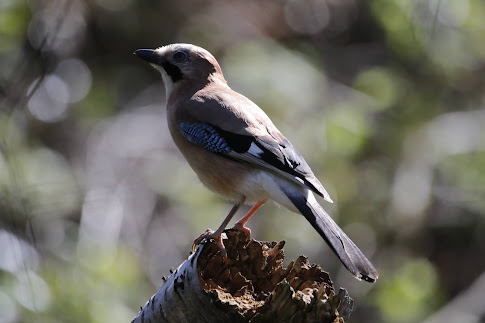An extreme rarity, a newly created species, unique to just one area of Europe, an IBERIAN CHIFFCHAFF showed up on the outskirts of Ipswich, when it should be in Spain. This was such an unusual record and being one that was nearly on my doorstep, I just had to go look for it. It had been present for a couple of days but it was only today I had the chance to catch up with it. I don't normally twitch, the part of birding that chases rare birds, but I couldn't resist the urge and went over to Eastern Ipswich to bag a lifer.
This is one of those birds that get people annoyed with twitchers, its one of those little brown jobs, almost identical to our own chiffchaff, separated only by a slightly different song. CHIFFCHAFFS are very common birds and there were lots of them singing throughout the woodlands. The common chifchaff has a monotonous 'chiff-chaff' song likes its name, however the Iberian starts off with a 'chiff-chaff' but ends with a trilling sound. Yep, that's all it takes to differentiate the two species. It has only recently been separated from our chiffchaff into two separate species, by scientists, which means it never got any attention before that. Yes, the bird doesn't quite get the juices flowing like an eagle or a crane, but it had its own charm, and it was a real test of bird watching skill to tell it apart from the more local birds. It had a more distinct eye stripe and a white chest compared to the common chiffchaff, but nothing that stood out.
With the advent of technology, birding has been changed forever. On the internet every record of every bird has been been published, so its easy to know what's about before you go anywhere. Also I was able to play a youtube video, on my phone, of the bird in song, next to the real singing bird just so I could confirm it was an Iberian Chiffchaff I was listening to. A part of me disapproves, its not proper fieldcraft, but another part me feels the exact opposite, of how easy it makes birding. A few other birders were present, but not many considering the bird's rarity and closeness to Ipswich. It was quite good to meet local birders and to get their lowdown on the local area, and I felt important telling newly arrived birders where the chiffchaff was - walk to the stadium, take the main track down and its in that area, where its singing its heart out.
The IBERIAN CHIFFCHAFF took up brief residence at Foxhall Heath on the outskirts of Ipswich. Despite living in Ipswich for a long time this was my first visit, because I live on the other side of the town, and I had no reason to go here before. Its part of the few remnants of the Sandlings heaths left in the area, an area of heathland which used to spread all along the |Suffolk coast. Its overgrown with secondary woodland, mainly silver birch, and being next to a housing estate was full of joggers and dog walkers, many of whom were curious with what me as a birdwatcher was up to. It was quite difficult to explain what I was doing, staring up at a bird in a tree taking pictures with my big old camera. At this time of year the woods were full of bird song and surprisingly there were quite a lot of birds about. On the edge of the heath was Mill Stream Local Nature reserve, a lovely area of marsh, ponds and thick scrub, in a little river valley, where, of course, the CETTI'S WARBLER could be heard booming out.
Its always good to get a lifer, even if it wasn't the most exciting of birds to see. This was a birdwatcher's bird, one that was a real test of fieldcraft one that wasn't a given, just to turn up and tick off, but one that took some effort to identify. Twitches are quite sociable for birdwatchers, a hobby not really for those who like company, so its good to catch up with other birders and to be able to talk about birds with people, the only thing I know about, and which I can't do with normal, non-birding people. Birdwatching is such a nice hobby and days like these are why I like it so much, which makes me sad that tomorrow I go back to work.





No comments:
Post a Comment